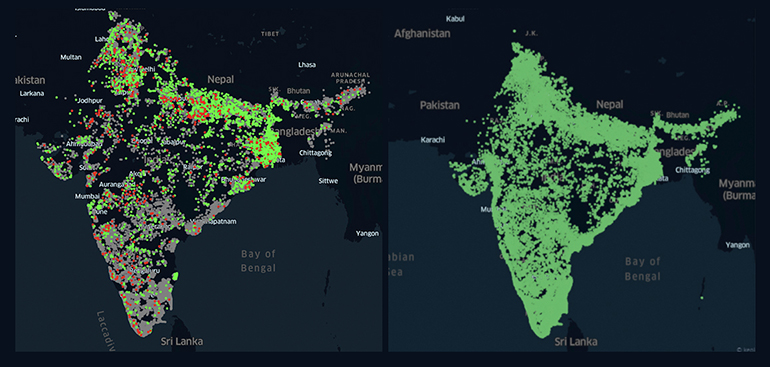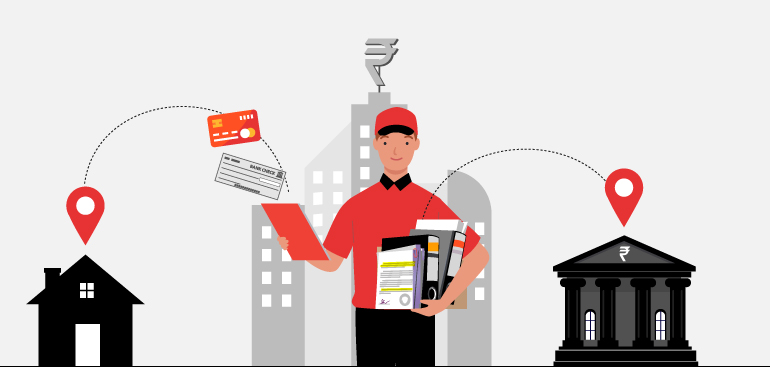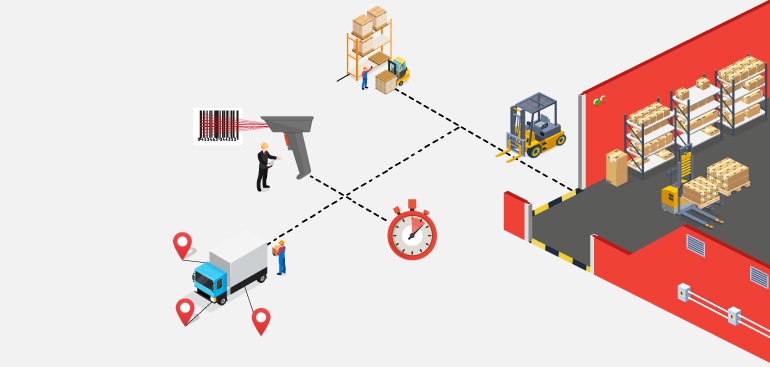What do you do when millions of shipments in your nationwide logistics network, designed for speed, become ineligible for delivery with immediate effect? When the rules of what can be delivered where, are changing on a real-time basis? When your clients are unsure of how to continue their business?
As the data science and technology team of a logistics innovator, how do you support the thousands of resolute COVID warriors of the operations team, who are braving the on-ground fear and confusion, to maintain what has suddenly become a primary lifeline to supply essential goods across the country?
You roll up your sleeves, repurpose the data science muscles you`ve built over more than 700 million successful deliveries, and get to work!
This is how technology helped us go from 0 active pin codes on March 24, the beginning of the lockdown, to being fully functional across over 15000 pin codes by April 1.
ENTER LOCKDOWN – FIGHT, FREEZE, FLEE? FLEX!
When the COVID threat began spreading internationally, Shipacko was an early adopter of precautions to prevent the spread of the virus. The foresight of our leadership team resulted in work from home for our corporate staff from March 5. Strict sanitization, social distancing, protective equipment usage, and best practices for a COVID afflicted world were already in effect throughout the network. Shipacko stocked up on masks and sanitizers and distributed over a million kits to local authorities.
On March 24, the nationwide lockdown came with little warning, as cases continued to escalate rapidly. Overnight, the government issued instructions to allow movement of only essential goods, and no physical movement would be allowed without specially issued passes to providers of essential goods and services.
The scramble for curfew passes, and intense coordination with local authorities was on.
Utter confusion and worry overshadowed the Indian business ecosystem. Sellers of essential goods were ramping up supplies, while others were pivoting from extremely different businesses to cater to the needs of the day. No one knew how the future was going to pan out.
Most importantly, no one knew how the goods they sold or manufactured would reach their eventual users.
Challenge 1- Taking stock
The Shipacko transportation network has been purpose-built to move goods faster, from one place to another. At the time the lockdown hit, and non-essential goods could no longer be delivered, our immediate prerogative was to separate the goods in our network which could be shipped from those which couldn’t.
Challenge 1, accepted – Enter Catfight
Different companies shipping with us use different, unstructured, and often non-standard product codes, category codes, and descriptions for their goods.
Over the years, we have learnt to categorize the type of goods that are shipped in our network, from the point of view of security, safety, and evaluating whether a particular package can be shipped by air.
Catfight is Shipacko’s proprietary machine learning-based product categorization tool that derives category and subcategory information from an unstructured product description.
Overnight, we repurposed this ability to identify essential and non-essential goods in the network and separate the essential goods that needed to be moved, from those which needed to be set aside for the time being.
{"data": [{ "prd": "ayurvedic nasal drops","cat": "Health and Wellness","scat": "Pharmacy Products","is_esntl": true,"res_code" : 3001}],"req_id": "ctf8|104 fc80-2149-4caa-9664-3cd797f"}
In the days to come, the definition of essential goods would continue to evolve as different state governments started to ease these restrictions. Our ear to the ground would help us understand which goods were being allowed to be delivered and help us keep the list of essential goods updated.
This would turn out to be a crucial ingredient for businesses to reboot in the days to come, as we would advise our clients on the goods they could ship, without fear of having their stock stuck in the logistics network.
Challenge 2- Where can we deliver?
Containment Zones were coming up across the country, in areas with high Covid incidence, with limited access allowed to people within them. Shipments to be delivered here could be delayed at the last mile as they would require the consignee to come to the access points at the edge of the containment zones to collect their shipments.
The ability to identify the shipments destined for these zones in advance, was key to managing our operations and in providing correct information to shippers and consignees.
Challenge 2, accepted – Enter Addfix
Addfix is Shipacko’s proprietary address disambiguation service that leverages machine learning techniques to convert unstructured addresses into a more consumable form.
Simply put, in the absence of standardized address formats, users write the same address in many different ways, which may include alternate spellings, conflicting geographical information (e.g., two unrelated localities), or missing information (e.g., forgot to write pin code).
Over the journey of 700M+ deliveries across India, we have built the unmatched ability to convert barely intelligible user generated addresses into their meaningful structured version.
Why was this now so important? For starters, it allowed us to take different definitions of containment zones called out by state or city authorities and understand the geographical element that corresponded to the zone description. The second thing it did, was to help understand whether a particular shipment with a poorly written address (like the one in the image above) belonged to a containment zone or not.
Close on the heels of the first lockdown came the definition of red, orange, and green zones, which added further complexity to what could be shipped and made our ability to disambiguate addresses even more critical than before.
In addition, we discovered that many areas were being locked down at the discretion of the local authorities or residents with information not published anywhere. Again, our ear to the ground helped us to identify these localities with the help of reason codes provided by our field operators.
With our location intelligence engine purring gleefully in the face of the challenges on the ground, we were able to immediately turn around to create a COVID Map interface not just for our own teams, but also for our client partners and the general public.
Challenge 3: Get back in the game
Let’s give a sense of how quickly this transpired.
On March 24, when the lockdown was announced, Shipacko and all logistics companies in the country were operational in 0 pin codes.
Within days we had our mapping of ‘what’ could be shipped ‘where’ in place. We had our feedback loops from the ground on essential goods definition and restricted localities – to have complete visibility of the actual situation that no one else – client, consignee, competitor, or even government – was able to capture in totality.
Every shipment at every facility in our network had a Ready To Ship (Yes/No) flag based on this intelligence.
Within 7 days, Shipacko was active in 15,500+ pin codes. We had transformed the way we conducted our business in record time to meet the COVID challenge.
Challenge 3 – pwned.
THE GREAT INDIAN REBOOT
Our network was now moving like clockwork. The situation on the ground kept changing rapidly and without warning. The incredible resilience and ingenuity of our Ops team, combined with our ability to assimilate and integrate any new circumstances into our technology ecosystem, helped us navigate the coming days within an efficiency unmatched in the country.
However, we still had to help Indian businesses to move out of paralysis and restart their activities immediately. During this period, our business development team continued to on-board hundreds of clients across Pharma, Retail, and FMCG distributing critical supplies, and many others, left without a reliable logistics partner.
Visibility
Clear visibility about the eventual fate of their shipments was the most significant piece of information that businesses needed to restart their operations.
We provided visibility to large, medium, small businesses, and individual consumers on their respective interfaces from the moment the shipment manifested to the moment it reached the consignee. This included information on the status of restrictions at the consignee address, as well as the current essential/non-essential status of what they were trying to ship.
Shipacko also externalized its categorization and location intelligence APIs. Our clients could now use our capabilities to accelerate their reboot process.
Activation
We noticed two interesting trends through the course of the close interactions of our BD teams with clients.
Many clients were not targeting business in different parts of the country as they were unaware of the on-ground situation. We also noted that many clients previously shipping essential goods had become inactive.
A quick analytic interface was set up for our BD teams to see the activity patterns by pincode and goods category for each client – large or small, and our BD team rapidly enabled businesses to ship over a million shipments, from categories and to pincodes that they were unsure about shipping.
Client activity – 1500 pin codes
With BD support – 15500+ active pin codes
A Picture of Resilience
The COVID threat across the world had already made the annual operating plans of every business obsolete. We went back to the drawing board to make fresh projections in the face of the inevitable economic slowdown, still setting ambitious targets for the year to come.
However, our ability to rise to the occasion – whether it was the operations resuming on-ground, or business development onboarding stranded customers, or tech and data science helping us place our next step with surety – meant that we were back in business with a bang.
Graph 1: Essential volumes
A brief period of degrowth can be seen in essential goods during Lockdown 1, as businesses were focused on their ability to ship essential goods, getting permits for their operations, and our own network was completely shut down for two days.
Changing customer purchase behaviour, focused towards stocking up on food, medicine, grocery – the essentials – and our rapid enablement of movement of these goods led to a surge in essential goods movement – higher than normal periods, despite on-ground challenges.
The subsequent period of growth was fuelled by our client activation activities which included our up-to-date publishing of information on newly designated essential goods categories derived from our ground intelligence.
Graph 2: Non essential volumes
Non-essential goods saw the biggest period of inactivity.
The flatlining of non-essentials through lockdown 1 and 2 reveals the strict government clampdown and our guidance to clients to avoid shipping non-essential goods that could not be delivered. However, the growth of non-essential volumes remained critical for restarting the economic engine.
We can see the rebound in non-essential volumes as soon as the government introduced the concept of red/ orange/ green zones and relaxed restrictions in green and orange zones. As further relaxations were introduced, our clients were the first to be notified of what they can start shipping again, leading to steady increase in volumes, even in red zones.
By June, our volumes in this segment had left the pre-covid volumes far behind.
HOW WE GREW THROUGH THE LOCKDOWN AS A COMPANY
Crisis reveals character.
Perhaps in the lifetimes of our young team at Shipacko, never before has a crisis of this proportion been heard of, let alone encountered. We stood up to deliver, and learnt three very heartening lessons about ourselves as a team, that we had always believed, but had now witnessed, beyond doubt, through our performance in a global crisis.
We care
There were no COVID lay-offs at Shipacko. Stable job opportunities continued to be available for both on-roll and off-roll staff. Clients had been given access to our exclusive intelligence capabilities, to restart their businesses. Our CEO and Exec leaders held daily 4 pm AMA sessions to ensure that they could assuage any team member`s anxiety about their future or the future of the company.
We are resilient
In the face of numerous, continuously emerging on-ground challenges, we were back on our feet and consistently delivering in the circumstances, closely working with every stakeholder to ensure uninterrupted shipping of essential goods to end customers at the time of their greatest need. Senior management was present in the facilities, ensuring operators had adequate safety measures and support in dealing with authorities. Tech and data teams were working around the clock for weeks to make our ground operators` lives easier.
We are agile
We were able to set up new operational practices and re-purpose our core technology strengths rapidly, helping us completely refashion the way we run our business and take our clients, old and new, along, in this journey of navigating a very fluid and unpredictable ground reality.
Business Development, Client Experience, Operations and Data/Tech Product teams took initiative both individually and collectively, collaborating rapidly and iteratively, to create a constant feedback loop between ground conditions, clients and the Shipacko network.
As a team, we have learnt an important lesson about ourselves – no matter what the circumstances are – we will deliver.


